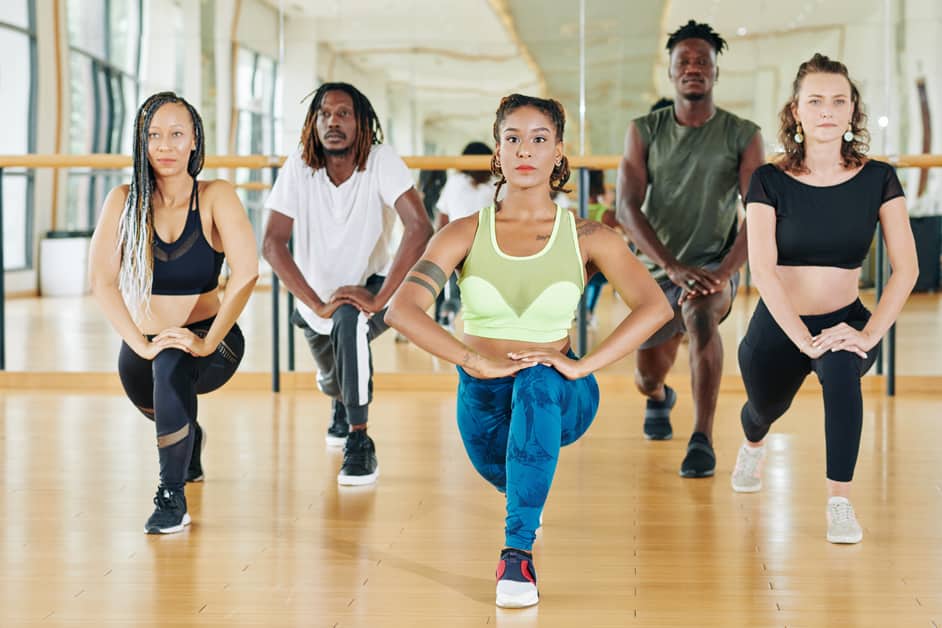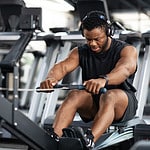Preparation
Workouts need stretching. Schedule it! Before and after lifting weights, stretch your muscles. This will decrease the chance of getting hurt, boost your joint range, and keep you flexible. Especially for knees, stretching is important. It reduces knee stress and tension.
Here, we talk about how to stretch your knees post-workout:
Warm up your muscles
Before weightlifting, warm-up your muscles. Do some light cardio and dynamic stretching. This helps reduce risk of injury. Dynamic stretching is when you take a joint through its full range of motion. Squats, lunges, jumping jacks, walking lunges and arm circles are good warm-up activities.
When finished, cool down properly. Light walking or jogging then static stretching is good. For static stretching, hold a stretch for up to 30 seconds. This increases flexibility and targets muscles used during the session. Stretch calves, hamstrings, hips and quadriceps.
For further relief of muscle soreness, use foam rolling post-workout. Focus on glutes, quads and hamstrings. This helps with recovery time after a strenuous session.
Wear comfortable clothing
Wear something comfortable for post-weightlifting stretching. Athletic clothing such as workout pants and a light top are best. Remove jewelry to keep it from binding or chaffing. Be aware of your body’s range of motion. Move slowly into stretches to avoid injury. Make sure it’s free from distraction so you can focus on stretching and recovering.
Stretches
Stretching is crucial for any weightlifting session. It can reduce soreness, stiffness, and enhance flexibility, preventing injury. We’ll talk about stretches especially for your knees. They help you stretch your knees after a weightlifting session. So, let’s get to it!
Quadriceps Stretch
The quadriceps stretch is the must-do stretch for your knees after a weightlifting session. It lengthens and loosens the thigh muscles, especially around the knee joint.
When stretching your quads, stand with feet hip-width apart and point toes forward. Reach back and hold onto a sturdy surface, like a chair or table. Step back with one foot and rest all your weight on that foot. Keep your posture steady and upright. Reach back and grab hold of the ankle of the same leg. Pull it up and push out your hips in opposite directions until you feel a gentle stretch on the front part of the thigh. Hold this position for 10-20 seconds. Release and shake out any tension between repetitions. Then repeat on the other side.
Hamstring Stretch
Hamstrings are muscles on the back of your thighs. They help with exercises like squats, deadlifts, and lunges. It’s important to stretch them after a weightlifting session. This will increase flexibility and lessen tension in your legs.
The hamstring stretch is a great way to loosen tight hamstrings. Stand with feet hip-width apart. Then, hinge at your hips and put both hands on your knees. Bend forward as far as you can. Don’t let your lower back round or cave. Hold for 30 seconds to one minute. Breathe deeply and release any tension in the area. You should start to feel relief after a few seconds. If needed, you can gently bounce at the hips for an extra release. When done, stand tall and shake out any remaining tightness from your leg muscles. Then, do light cardio like jogging or walking.
Calf Stretch
The calf stretch exercise is great for improving flexibility in the calf muscle. This can prevent injury and help your comfort when you move.
To do it, stand in front of a wall. Put your feet 1-2 feet away and arms out. Keep your heels on the floor and lean into the wall. You’ll feel a mild stretching sensation at the back of your lower leg. Hold this for up to 30 seconds. Then, gently release and repeat.
To increase intensity, stand farther from the wall or use a stability ball. Remember to keep your core engaged for best results and minimal injury risk.
Gluteal Stretch
The gluteal stretch is a simple, effective stretch. Do it anytime and anywhere!
- Stand with feet slightly more than hip-width apart, toes facing forward. Bend knees slightly.
- Extend one leg backwards, parallel with the floor. Reach back and hold onto the toe of extended leg’s sock. Or, clasp hands just above it.
- Lift chest and draw in navel towards spine. Hold for 10 seconds. Repeat two more times on each side. Then, switch legs.
- When performing this stretch, keep hips facing forward. Don’t let them rotate.
- Feel a gentle stretch in both glutes. No strain or discomfort!
- Remember to breathe. Holding breath limits its beneficial effects!
Hip Flexor Stretch
Stretching your hip flexors is essential for healthy knees after weight lifting. These muscles, located at the top of your pelvis, control the hip joint. When they become tight, it can cause pain in the knees.
Here’s how to do it:
- Stand with feet shoulder-width apart. Lean your hips back until you feel a slight stretch.
- Hold this position for 15-20 seconds. Repeat 2-3 times on each side. Take breaks as needed.
- For more intensity, tie a band or towel around your thighs or move closer to a wall for added stability.
- Don’t overextend. Listen to your body and don’t push past any discomfort.
Stretching is key for weightlifters. Squatting and deadlifting can cause tightness in the hip flexors, which can lead to postural issues and knee pain. Regular stretching prevents injury and helps optimize performance.
Post-stretching
Stretch your knees post weight-lifting! It’s a smart way to keep your muscles chill and lower injury risks. To gain peak performance, and stay safe, warm up and stretch properly. Here’s what to do:
- Stretch your knees after a workout session.
- Do it right to boost results and be safe.
- This article has the steps needed for proper knee stretching.
Take a few deep breaths
Stretch and take a few seconds to breathe deeply. This can help relax your muscles and get rid of lactic acid. Let your breath move throughout your body and clear away worries or fatigue. If you’re stressed out, focus on something positive. It could be a peaceful view or repeating affirmations like “I am strong“.
Allow yourself to rest and enjoy the moment. These moments of calmness are great for recharging energy and managing stress.
Drink plenty of water
Post-stretching, it’s essential to drink lots of water. Stretching may dehydrate your muscles. So, to help them recover, stay hydrated. Water helps muscles and joints absorb minerals and electrolytes. They are important for getting rid of toxins, lessening soreness, and avoiding inflammation. Plus, drinking water makes sure you have enough energy for future workouts.
Aim to drink 8-10 glasses of water daily. Use an app or tracker to watch your intake. Coconut water or sports drinks can also enhance your hydration routine post-stretching.
Avoid bouncing during the stretch
To dodge injury post-stretching, avoid “bouncing.” This happens when you stretch a muscle, then without holding, contract & repeat multiple times. It looks like warm-up or physical activity. Previously, it was thought to help flexibility, but research found it increases risk of injury.
Rather opt for dynamic stretching, a slow, controlled movement through the range of motion. This should involve speed control & steady force to avoid jerking motions. Pulsing movements can be used in a similar way, repeating moves within a comfortable range, to get used to feeling flexible.
Static stretches, usually held longer (15-60 secs) should only increase intensity a fraction of an inch each time & stop if feeling any pain. Do static stretches after some activity as otherwise it could cause an injury or pain if muscles not warmed up.
Additional Tips
Stretch those knees after a weightlifting session! It’s essential for joint flexibility and injury prevention. Besides static stretches, experiment with dynamic and ballistic stretches too. Boost your knee range of motion!
If you want more tips on knee recovery and injury prevention, keep reading!
Stretch before and after each weightlifting session
Weightlifting can be harsh on your muscles and joints – so warm up and cool down properly. Before the session, do some dynamic stretches to get your body ready and avoid any injuries. Examples of dynamic stretches are arm swings, toe touches, triceps extensions, knee dips, and T-spine twists.
After the session, do static stretches. Examples are shoulder rolls, standing quad stretches, chest openers, hip flexor stretches, and calf raises with heel drops. Stretching during rest periods can be useful too – if you have any tight muscles, take a break and stretch them out.
Listen to your body and don’t push too hard
Stretch your knees after weightlifting, but listen to your body. Don’t push too hard. Hold each stretch for 20-30 seconds. Stop if it’s painful or uncomfortable. Stretch slowly and gradually. Don’t overextend the knee joint.
Also, use other muscle groups. For example, if stretching for a squat or lunge, stretch ankles, hips and lower back. This helps flexibility and can reduce pain.
Sharp pains or aches in knee joints mean something’s wrong. Stop stretching immediately. See a doctor or physical therapist if needed.
Consult with a physical therapist if needed
If exercising causes pain or discomfort, it’s important to talk to a physical therapist. They can assess and diagnose your injuries and body mechanics. This helps them create an exercise plan tailored to your needs. They can also track your progress and change the program as you get stronger and fitter.
If necessary, the physical therapist can refer you to other healthcare professionals, like
- surgeons
- massage therapists
- nutritionists
Frequently Asked Questions
Q1: What are the best ways to stretch my knees after a weightlifting session?
A1: The best way to stretch your knees after a weightlifting session is to do a standing quadricep stretch and hamstring stretch. You can also do a knee to chest stretch and a standing calf stretch to get a complete stretch in your lower body.
Q2: How long should I hold each stretch?
A2: Each stretch should be held for 30 seconds to 1 minute for the best effect.
Q3: What can happen if I don’t stretch my knees?
A3: If you do not stretch your knees after a weightlifting session, you may experience pain and soreness in your knees and lower body. You may also be more likely to suffer an injury.





